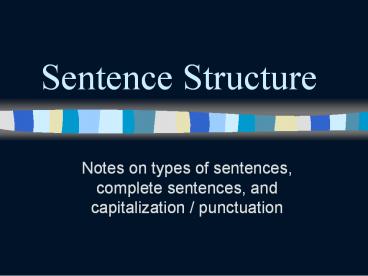Sentence Structure - PowerPoint PPT Presentation
1 / 18
Title:
Sentence Structure
Description:
Ex.) I passed the English test! Complete Sentences A complete sentence has both a subject and a predicate Subjects can be directly or indirectly stated. – PowerPoint PPT presentation
Number of Views:96
Avg rating:3.0/5.0
Title: Sentence Structure
1
Sentence Structure
- Notes on types of sentences, complete sentences,
and capitalization / punctuation
2
What is a complete sentence?
- A sentence is a group of words that expresses a
complete thought. - Example The alarm at the bank sounded late last
night. - A complete sentence must also begin with a
capital letter, and end with appropriate
punctuation. - A complete sentence has both a subject and a
predicate.
3
Types of sentences
- Declarative
- Makes a statement
- Ends with a period (.)
- Ex.) A beautiful house overlooks the river.
- Imperative
- Gives a command
- Usually ends with a period, but could end with an
exclamation point. (.) (!) - Ex.) Do ten more push-ups.
- Ex.) Hurry up!
4
Types of sentences cont.
- Interrogative
- Asks a question
- Ends with a question mark (?)
- Ex.) When is our test?
- Exclamatory
- Expresses strong emotion
- Ends with an exclamation point (!)
- Ex.) I passed the English test!
5
Complete Sentences
- A complete sentence has both a subject and a
predicate - Subjects can be directly or indirectly stated.
- Subject who or what the sentence is about
- Predicate the verb / tells what the subject
does or is
6
Complete Sentences
- Subjects and Predicates
- In declarative sentences in many, the subject
comes before predicate / in some, the predicate
comes before the subject - Example Alice tripped on something.
- Subject before predicate
- Example On the ground were two rocks.
- Predicate before subject
7
Complete Sentences
- Subjects and Predicates
- In interrogative sentences, part of the predicate
comes before the subject. - To find the subject, change the sentence into a
declarative sentence. Then, look for the subject
near the beginning of the sentence. - Example Can you fix my computer?
- Example You can fix my computer.
8
Complete Sentences
- Subjects and Predicates
- In most imperative sentences, only the predicate
is written or spoken. - The subject of the sentence is understood to be
there. This understood subject is always you. - Example Open the window.
9
Sentence Fragment
- A sentence fragment does NOT express a complete
thought. - Something is missing
- Examples
- Agreed to the plan. (Who agreed?)
- That red car. (What about the red car?)
- Late last night. (What happened?)
10
Run-On Sentence
- A run-on sentence is two or more sentences
written incorrectly as one. - Run-on The contestant hesitated too long the
buzzer sounded. - Correct The contestant hesitated too long. The
buzzer sounded. - There are other ways to correct this sentence -
we will get into that later!
11
Another type of run-on
- Comma Splice / Comma Fault
- The writer mistakenly uses a comma instead of a
period. - Run-on Ray began as a backup singer, now he
sings lead. - Correct Ray began as a backup singer. Now he
sings lead. - (In this correction, the writer made the run-on
sentence two single sentences.)
12
How to fix incorrectly written sentences
- Changing a fragment to a complete sentence
- Add the missing information (could be the subject
- who or what of the sentence could be the verb).
- Begin the sentence with a capital letter.
- End the sentence with ending punctuation.
13
How to fix incorrectly written sentences
- Changing a run-on to a complete sentence.
- 1st way Change the run-on to two single
sentences, both beginning with capital letters
and ending with the appropriate punctuation. - 2nd way Add a comma WITH a conjunction
- 3rd way Add a semi-colon
14
First way two single sentences
- Example
- Run-on The dog quickly ran across the road no
one could catch it. - Run-on (comma splice / comma fault) The dog
quickly ran across the road, no one could catch
it. - Correct The dog quickly ran across the road. No
one could catch it.
15
Second way Add a comma with a conjunction
- Example
- Run-on Susan already excels in art now she wants
to study music. - Run-on (comma splice / comma fault) Susan
already excels in art, now she wants to study
music. - Correct Susan already excels in art, and now she
wants to study music.
16
Third way Add a semi-colon
- Example
- Run-on The judge entered the courtroom everyone
rose. - Run-on (comma splice / comma fault) The judge
entered the courtroom, everyone rose. - Correct The judge entered the courtroom
everyone rose. - The semi-colon allows two independent clauses to
stand together in a single sentence. - Remember an independent clause is something that
can stand alone and make sense its
independent!
17
Capitalization
- There are a set of rules in a packet I will give
you on capitalization - These come straight from OGTs Buckle Down a
practice book to prepare for the OGT - It will be important you dont lose this packet
18
Punctuation some basics
- Comma (,)
- Used as a separation device
- Used to join 2 independent clauses with a
conjunction - Colon ()
- Used before a list or explanation
- Acts as a gate, telling you to go on / keep
reading - Semi-colon ()
- Used to separate 2 independent clauses in a
single sentence - Quotation Marks ( )
- Used for when someone is speaking / quotes































